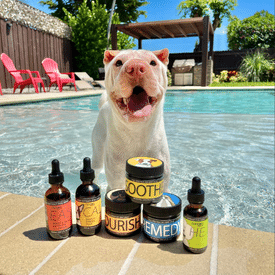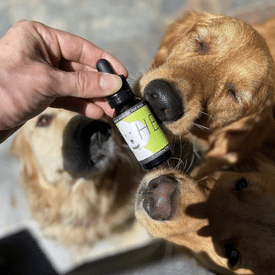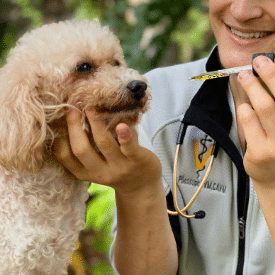CBD for Dogs with Luxating Patella Conditions

Just hearing the words “luxating patella” can be overwhelming. Thankfully there are holistic options like CBD for dogs with luxating patella. Once you understand more about luxating patella in dogs, it can make the thought process a lot easier. Keep in mind when you are hearing scientific jargon, sometimes the sound of the ‘science’ can make you feel overwhelmed, but by understanding what it is, you can put your mind at ease.
Table of Contents
What is Luxating Patella?
The patella is a bone, the kneecap actually, that’s generally floating in a groove-like area at the end of the thigh bone (femur) above the knee (scientifically known as the stifle).
The luxating portion means ‘out of place.’ Now, putting these two definitions together, we can conclude a luxating patella in dogs is a kneecap that moves out where it’s meant to be. That sounds a bit better, right?
If your dog’s kneecap isn’t in the right position, you may notice your dog’s walk being a bit off or watch her run on three legs rather than all four. In some cases, all of a sudden, your dog could be walking on all four legs again. To put it mildly, it just seems weird to most pet parents.
You aren’t alone. I have seen dogs do this and then act as if nothing happened. Then, I start to wonder if it happened in the first place. That’s why it’s important to keep an eye on it if you notice it even once. Remember, dogs instinctively act like nothing’s wrong until they have no choice not to.
What’s The Cause of Patellar Luxation in dogs?
Now, what’s the cause of your dogs luxating patella, or ‘out of place’ kneecap? The kneecap sits below a ligament called the patellar ligament. The ligament attaches the thigh muscles to your dog’s shin bone. When the thigh muscles contract, the patellar ligament is ‘activated’ and pulls on the shin bone resulting in the knee straightening.
If you play around with your own knee, you’d notice your knee does move around a little. The purpose of this movement is to allow the patella (the knee) to slide up and down in a groove (trochlear groove) and keep the ligament in place during movement.
The ligament should be attached to the center of the shin, but in cases where there is patellar luxation, the ligament may be in the wrong place. Usually, it’s located too far toward the middle of the dog’s body, this is known as “medial placement”. After abnormal movement for a period of time, the groove in the femur bone may wear down. Without that groove, the patella (the knee bone) can dislocate.
Now that we have that handled, it’s important to understand there are many small breeds prone to luxating patella. It’s just in their genetics.
Long-Term Effects of Patellar Luxation in Dogs
Whether or not this will cause problems for your dog depends on the severity of the luxation and whether or not both legs are affected. There are some dogs who can go on to live perfectly normal lives with patellar luxation. There are others who may further injure their knee accidentally by tearing other ligaments. Arthritis may also begin to set in making it harder for a dog to walk properly.
Conventional treatment of Luxating Patella in dogs
Surgery may or may not be an option for dogs with luxating patella. In many cases, pet parents opt out of the surgery as this is generally found in older dogs. In conventional medicine, if a pet parent opts out of surgery, prescription anti-inflammatories may be recommended, but along with them comes a whole slew of side effects.
CBD for Luxating Patella in Dogs
CBD for dogs with luxating patella conditions offers a natural, safe option for reducing inflammation and reducing the pain associated with patellar luxation.
Here are some potential benefits of CBD for dogs with luxating patella conditions:
- Pain Management: CBD is known for its analgesic (pain-relieving) properties. It may help alleviate pain associated with luxating patella, promoting your dog’s comfort.
- Anti-Inflammatory Effects: Luxating patella in dogs often involves inflammation. CBD has anti-inflammatory properties that might help reduce inflammation in the affected joint, potentially easing discomfort.
- Muscle Relaxation: CBD has muscle-relaxant properties, which could be beneficial if the condition is causing muscle tension or spasms around the affected area.
- Anxiolytic Effects: Chronic pain and discomfort can contribute to anxiety in dogs. CBD may help reduce anxiety, promoting an overall sense of well-being.
- Support for Joint Health: CBD may have a protective effect on joints and cartilage. By promoting joint health, it might contribute to the overall management of conditions like luxating patella.
Related: CBD vs NSAIDs for Inflammation in Pets
Tater’s Luxating Patella CBD Success Story

Tater was diagnosed with not one, but two, luxating patellas, as well as hip dysplasia in both hips and arthritis. That’s a lot to take in and it’s no wonder he was hardly able to walk when his foster parents took him into their loving home.
His foster parents decided to give CBD a try to see if it would help improve his quality of life. Guess what? IT DID! Tater was provided with 1 mL of HEAL 1100 mg Full Spectrum Hemp Extract once per day in the mornings.
We checked back in with his foster parents to find out amazing news. Tater is now able to walk AND RUN without pain! Imagine not being able to walk hardly at all, and likely be walking with extreme pain, to running like a pup again!
Tater’s foster family also reports that his arthritis and his appetite have both improved. His quality of life went from being extremely low to incredible with the ability to enjoy the ‘small things’ in life like walking and running again. Tater continues to take HEAL daily.















